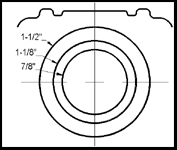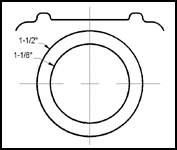MANUFACTURERS
The Scalloped Swirl pattern was first made by Ripley & Co (Ref 1,2). The
first Ripley & Co. was established by Daniel C. Ripley and several
partners in 1866 in Pittsburgh and specialized in flint, cut, and engraved
glass. In 1874 Ripley established his own company, where he made pressed
glassware, bar glass, and lamps (Ref 2). Since the first company apparently did
not make pressed glass, we assume that the Scalloped Swirl pattern was
designed and fabricated by the second company sometime after 1874. Revi (Ref
2) shows a grouping of a
Covered Sugar and a Cream, a Spooner, and the
Butter and Cover (pictures from our collection) from a Ripley catalog (undated
by Revi). Revi (p294) states that Ripley & Co. made the Scalloped Swirl
pattern starting in ca. 1885. McCain (Ref 1) shows a line drawing of a
salt and indicates that the pattern is also known as "York
Herringbone".
In 1891 Ripley & Co. joined the United States Glass company (a
grouping of 18 separate companies). The US Glass Co. reissued the Scalloped
Swirl pattern starting in ca. 1892 calling it No. 15,026 (Ref 1), certainly
an uninspiring number (not even prime) for such a nice pattern. Revi shows a
U.S. Glass Co. catalog picture of a Scalloped Swirl tumbler (Ref 2). One of
our pieces is an 1893 Worlds Fair souvenir ruby
stained tumbler so we know that piece was made after Ripley joined the
U.S. Glass Co.
The U.S Glass Co. went bankrupt in 1963 (Ref Archival
Collections , Bowling Green State University). The Archival Collection
referenced here is a most interesting site. It includes a short history of
the USG Co. and the Tiffin Glass Co. and lists their inventory of documents
from the US Glass Co and its successor the Tiffin Glass Co. The inventory
includes financial records from USG Co. and Tiffin, and glassware
photographs, sketches, pattern rubbings, mold designs, and machinery
blueprints from, apparently, Tiffin. Note that the actual items are not
'on-line', just their inventory.

SCALLOPED SWIRL PICTURES
Pictures and the dimensions of our Scalloped Swirl pieces can be found here
Or by pressing this
 on this page.
on this page.
VARIATIONS
Toothpicks
We have three ruby stained and two crystal toothpicks in our collection.
Don't ask why we have five, it just happened.
The three ruby stained toothpicks are noticeably taller, by 1/8",
than our two crystal toothpicks. I am not sure to what this anomalous
difference can be attributed. Certainly when the glass solidifies in the
mold, it shrinks. The shrinkage will depend upon the chemical composition of
the glass, but I see no reason for the composition to differ between the crystal
and the ruby stained pieces. The ruby stained pieces, I believe, are subject
to a second 'firing' after application of a salt, but there is no reason that
I can see that a second heating could increase the size. Perhaps the two
crystal and three ruby toothpicks happened to have different chemical
compositions and so shrunk at different rates or they were by coincidence
made in different molds with slightly different dimensions. I believe the
later is more likely. After all, the toothpicks must have been one of the
cheaper items so probably many were made and many molds needed. It wouldn't
have been necessary to maintain precise tolerances between molds so plus or
minus 1/16" might be acceptable and thus a difference of 1/8" might
be quite reasonable.

Salt/Pepper Shakers
We describe two different styles of salt/pepper
shaker bases and three kinds of metal tops.
TYPE A BASE

|
|
TYPE B BASE

|
|
The bottom of this shaker consists of a recessed central
7/8" D boss surrounded by a 1-1/8" ring. The base itself is
1-1/2" in diameter. The drawing above shows a plan view and a
cross-section of the base. The thread on this shaker makes only one turn
and the rim is smooth.
|
|
The recessed central boss is absent on this style. The
base itself is 1-1/2" in diameter. The inner part of the base is about
1-1/8" in diameter. The drawing above shows a plan view and a
cross-section of this base. The thread on this shaker makes two turns and
the top of the rim is rough.
|
METAL SHAKER TOPS
We are quite sure that the 'domed top' and 'raised top described here are
old. We are not sure if the 'depressed' type (not shown) is old, and we do
not know if any of these were supplied by Ripley or US Glass. McCain (Ref 1)
does show a line drawing of a Scalloped Swirl salt with what appears to be
the 'domed' top.
Domed Top
The domed top does not show the threads on the outside. It is a heavy
material, probably zinc, and seems too thick to have been stamped and so may
well have been cast. I would, however, be surprised if it were a casting
since that would be an expensive process for such an inexpensive item. It has
a dull grey finish. The 15 holes in the top are approximately 3/16" D
The salt would really pour so we put a thin cardboard insert with small perforations
under the top).
Raised Top
The raised top is stamped from a non-ferrous metal which may be nickel or
nickel plate (portions have retained a shiny finish). The top surface is
slightly raised. The threads are visible on the exterior. There are 15
1/8" D holes.
Depressed Top
The 'depressed' top is a stamped from aluminum. Since the material is
Aluminum it is not particularly old and certainly not 19th century. The top
surface is slightly depressed. It has a dull finish and does not look at all
like the contemporary replacement tops we have. The threads are visible on
the exterior. There are 15 1/8"D holes.

NO LAMP
We were disappointed to find that no Scalloped Swirl kerosene lamp seems to
exist. But we found a grand substitute. The Coolidge
Drape lamp is a close match and is a nice piece.
COLORS
McCain (Ref 1) states that the Scalloped Swirl pattern can be found in
Crystal, Ruby Stained, Green (scarce), and Blue (scarce). The only piece in
green that we have is the small (individual) creamer, and we have never seen
a blue piece.
SIMILAR PATTERNS
McCain (Ref 1) shows two patterns that are similar to the Scalloped Swirl.
The 'Heavy Drape' pattern made by Fostoria has the characteristic scallops
but does not have a smooth thumbprint-like space between the rows of
scallops. The Coolidge drape (only a lamp?) scallops are separated by a
narrow band of steps, not a smooth thumbprint. None of the other 'swirl'
patterns shown in McCain can be mistaken for the Scalloped Swirl.

ABOUT US
We are mostly just collectors, but we do sell some antiques and collectables
at a few shows in Minnesota. Our Scalloped Swirl collection started with the large
water pitcher and one crystal tumbler that came from Al's grandparents
who lived near Madison S.D.
The first time we ever saw another Scalloped Swirl piece was at a show in
Minneapolis in about 1998. C & R Antiques from Connecticut had one or two
ruby stained cordials. We knew very little about pattern glass and our
pattern, but Chris and Rena gave us a fine short tutorial about EAPG and York
Herringbone. We foolishly didn't buy the cordials since I thought we wanted
crystal pieces only. We have since become wiser. In fact, we got our ruby
stained butter dish bottom from the them.
Joan Winn and Jack Burke have taught us a great deal and have often been a
source for nice pieces.
We have often looked at other wonderful patterns, but we've avoided
starting another collection until recently. We have picked up a few creamers
in various patterns and some pieces in the 'Red'
Block pattern. It looks like we've started another collection. We do have
a curious shell pattern bowl and a stem that we cannot identify. Perhaps
someone can help us.
If you find errors or omissions on these pages, please let us know
Al and Sandy)

References
1. McCain, Mollie Helen, "Field Guide To Pattern Glass", Collector Books,
KY, 2000.
2. Revi, Albert Christian, " American Pressed Glass and Figure
Bottles", Thomas Nelson Inc., NY, 1964.
|



